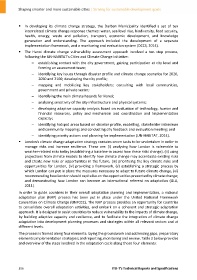Page 566 - Shaping smarter and more sustainable cities - Striving for sustainable development goals
P. 566
In developing its climate change strategy, the Durban Municipality identified a set of ten
interrelated climate change response themes: water, sea level rise, biodiversity, food security,
health, energy, waste and pollution, transport, economic development, and knowledge
generation and understanding. The approach included the development of a separate
implementation framework, and a monitoring and evaluation system (DCCS, 2014).
The Hanoi climate change vulnerability assessment approach involved a ten step process,
following the UN‐HABITAT's Cities and Climate Change Initiative:
– establishing contact with the city government, gaining participation at city level and
forming an assessment team;
– identifying key issues through disaster profile and climate change scenarios for 2020,
2050 and 2100; developing the city profile;
– mapping and mobilizing key stakeholders; consulting with local communities,
government and private sector;
– identifying the main climate hazards for Hanoi;
– analysing sensitivity of the city infrastructure and physical systems;
– developing adaptive capacity analysis based on evaluation of technology, human and
financial resources, policy and mechanism and coordination and implementation
capacity;
– identifying hotspot areas based on disaster profile, modelling, stakeholder interviews
and community mapping; and conducting city feedback and evaluation meeting; and
– identifying priority actions and planning for implementation (UN‐HABITAT, 2014).
London's climate change adaptation strategy contains seven tasks to be undertaken in order to
manage risks and increase resilience. These are: (i) analysing how London is vulnerable to
weather‐related risks today (establishing a baseline to assess how these risks change), (ii) using
projections from climate models to identify how climate change may accentuate existing risks
and create new risks or opportunities in the future, (iii) prioritising the key climate risks and
opportunities for London, (iv) providing a framework, (v) establishing a strategic process by
which London can put in place the measures necessary to adapt to future climate change, (vi)
recommending how London should capitalise on the opportunities presented by climate change;
and demonstrating how London can become an international referent on adaptation (GLA,
2011).
In order to guide countries in their overall adaptation planning and implementation, a national
adaptation plan (NAP) process has been put in place under the United National Framework
Convention on Climate Change (UNFCCC). The NAP process provides an opportunity for countries
to consolidate overall adaptation activities, and embark on a coherent and strategic adaptation
approach. It is designed to assist countries to reduce vulnerability to the impacts of climate change,
by building adaptive capacity and resilience, and to facilitate the integration of climate change
adaptation into development planning processes and strategies within all relevant sectors and at
different levels.
The process is framed along four elements: laying the groundwork and addressing gaps; preparatory
elements; implementation strategies; and reporting, monitoring and review. Table 2 below provides
and overview of the steps involved in the adaptation cycle along those four elements:
556 ITU‐T's Technical Reports and Specifications

